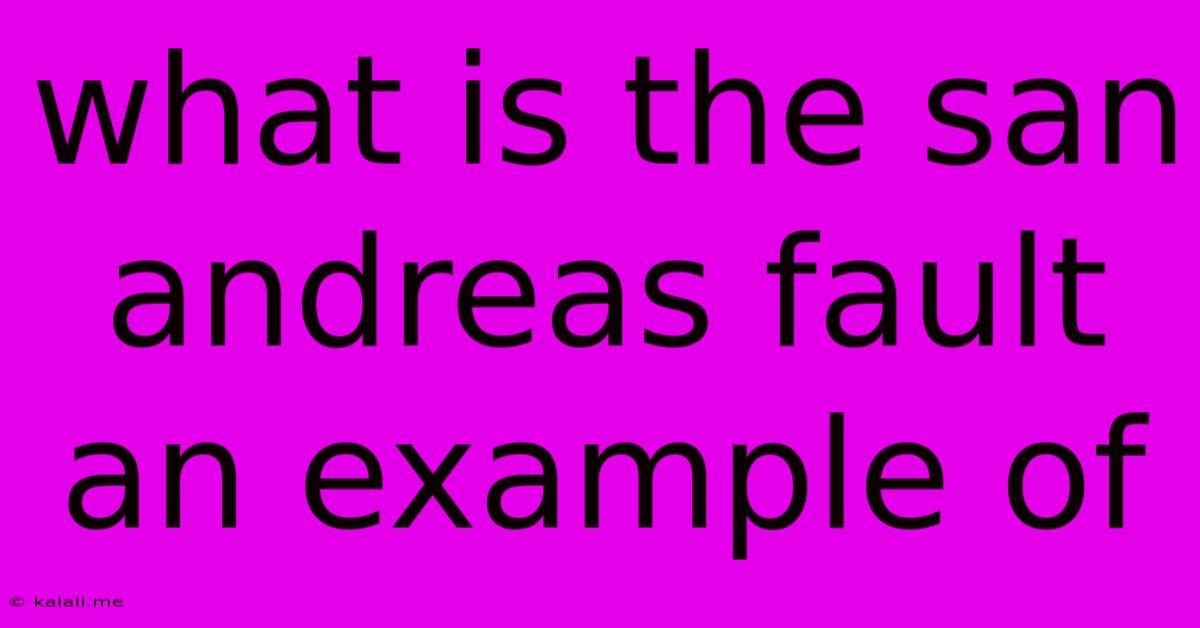What Is The San Andreas Fault An Example Of
Kalali
Jun 14, 2025 · 3 min read

Table of Contents
What is the San Andreas Fault an Example Of? A Deep Dive into Transform Plate Boundaries
The San Andreas Fault is one of the most famous geological features on Earth, a scar across the landscape of California known for its devastating potential. But beyond its notoriety, what exactly is the San Andreas Fault an example of? It's a prime example of a transform plate boundary, a type of tectonic plate boundary where two plates slide past each other horizontally. This article will explore this fascinating geological phenomenon in detail, examining its characteristics, consequences, and significance in understanding plate tectonics.
Understanding the San Andreas Fault requires grasping the concept of plate tectonics. The Earth's lithosphere, its rigid outer shell, is divided into several large and small plates that are constantly in motion. These plates interact at their boundaries, leading to various geological events. The San Andreas Fault is located where the Pacific Plate and the North American Plate meet. These plates aren't colliding or pulling apart; instead, they grind past each other, creating significant geological activity.
Transform Plate Boundaries: The Mechanics of Sliding Plates
Transform plate boundaries, also known as conservative plate margins, are characterized by horizontal movement of plates. Unlike convergent boundaries (where plates collide) or divergent boundaries (where plates move apart), transform boundaries don't create or destroy crust. Instead, the friction between the plates builds up immense pressure, leading to sudden releases of energy in the form of earthquakes. The San Andreas Fault vividly illustrates this process. The Pacific Plate moves northwestward relative to the North American Plate, causing the characteristic slip-stick motion that results in frequent seismic activity.
The San Andreas Fault: A Case Study in Transform Boundaries
The San Andreas Fault system is not a single, continuous crack, but rather a complex network of faults spanning hundreds of kilometers. Its length and the significant lateral movement between the plates make it a perfect illustration of a large-scale transform boundary. The fault's activity is responsible for the frequent earthquakes experienced in California, ranging from minor tremors to catastrophic events like the 1906 San Francisco earthquake. This earthquake, estimated at magnitude 7.9, dramatically demonstrated the destructive power of transform boundary activity.
Beyond Earthquakes: Other Geological Manifestations
The San Andreas Fault's influence extends beyond earthquakes. The movement of the plates has created unique geological features across the landscape. These include:
- Offset landforms: Streams, roads, and other features are visibly offset along the fault line, providing clear evidence of the horizontal movement.
- Linear valleys and ridges: The grinding action of the plates has sculpted the landscape, creating characteristic linear valleys and ridges.
- Fault scarps: These are steep cliffs formed by the vertical displacement of the Earth's surface during faulting.
The San Andreas Fault and Seismic Hazard
The San Andreas Fault is a major source of seismic hazard for California and surrounding regions. Understanding its mechanics and predicting its behavior are crucial for mitigating the risks associated with future earthquakes. Ongoing research utilizes various techniques, including GPS measurements and seismic monitoring, to enhance our understanding of this active fault system and improve earthquake preparedness. Predicting the exact timing of major earthquakes remains a challenge, but studying the San Andreas Fault significantly contributes to improving earthquake forecasting models. The fault's activity underlines the importance of building codes and emergency preparedness strategies in seismically active regions.
In conclusion, the San Andreas Fault is a compelling example of a transform plate boundary, vividly showcasing the consequences of horizontal plate movement. Its study not only provides invaluable insights into plate tectonics but also highlights the importance of understanding and mitigating seismic hazards in regions prone to such geological activity. The fault's ongoing activity serves as a powerful reminder of the dynamic nature of our planet and the immense forces shaping its surface.
Latest Posts
Latest Posts
-
Which Of The Following Is Not An Application Layer Protocol
Jun 14, 2025
-
Which Of The Following Is A Renewable Energy Source Weegy
Jun 14, 2025
-
Select All Correct Statements On Whistleblowing
Jun 14, 2025
-
What Is The Percentage Of 300
Jun 14, 2025
-
Which Of The Following Is Radially Symmetrical
Jun 14, 2025
Related Post
Thank you for visiting our website which covers about What Is The San Andreas Fault An Example Of . We hope the information provided has been useful to you. Feel free to contact us if you have any questions or need further assistance. See you next time and don't miss to bookmark.